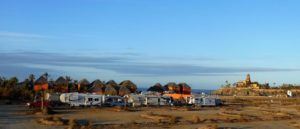
December 8, 2016 -On our last day in Los Barriles we had dinner at El Gecko’s and Barry & Viv joined us as our guests, by all accounts everyone enjoyed the experience, we will be back. We did get 5 of the 8 RVs washed, lots of work and Jorge has a much better idea of what resources are needed on our return for the next group. Overall the gang enjoyed their stay at Baja Sunrise and many wished we could have stayed another night. We were off the next day Pescadero bound heading to Los Cerritos.

We left Tim behind at Los Barriles as he needed to make a deposit for his later stay as we started our drive to the Los Cerritos Surf Colony. Our first stop was the Tropic of Cancer; they have really developed this site on Hwy 1, unfortunately the same cannot be said for Hwy 19 north of Todos Santos where they have never replaced the sign stolen years ago. Next was our propane stop where we thought we Tim would catch up, unfortunately the Cali-Gas sign was nowhere to be seen and we did see Tim on the side of the road waiting when we entered the outskirts of San Jose Del Cabo.
All together again we now headed thru San Jose onto the corridor to Cabo San Lucas. Lisa and I were both shocked at how much construction was ongoing since we were here a year ago, at least 10 major projects. We arrived at the San Lucas Plaza without incident and headed into Walmart to resupply. We did not realize Tuesdays were ½ price veggie day, the place was crazy busy. We met Peter from Vag’s Restaurant for lunch at the Food Court, caught up on local news and look forward to seeing Geraldine later at Los Cerritos.
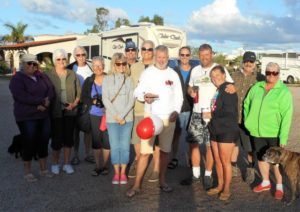
Our final stop was the Blanket Factory 2km before our destination. Vivianne was holding down the fort as Efrein was in Cabo and the kids at school. Vivianne had been expecting us and made some wonderful sweet buns in their beehive oven. Folks purchased many items for themselves and gifts for others. Chuck & Christina returned twice more for additional items. We rolled into the Cerritos Surf Colony about 3:30 pm, we were the only RVs in the place.
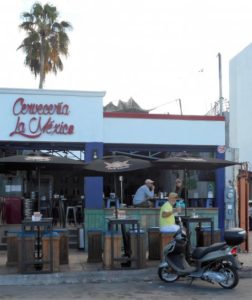
Looks like new owners are now in charge, a Mexican group from Sinaloa, apparently Roger will not be returning from the US. Maribell & Gilo seem to be the Managers now, not sure where Teresa went. Folks were a little apprehensive until they saw what came with our dry camping, all smiles then. We had our tour into Todos Santos, lots of pool time, a couple siestas and dinner at La Pasadita which was a real hit as always. We did manage to see Peter & Geraldine and another couple from Vancouver, a short visit as Peter wisely needed to get on the road before dark. Lisa and I look forward to the day when we are not on tour and can spend more time visiting our Baja friends. We are not running a January tour so this will happen sooner than later. Fair to say lots of good memories made at Los Cerritos Surf Colony in Pescadero and Todos Santos by members of our group.
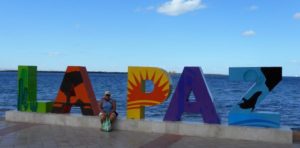
After 3 nights onwards we traveled back to La Paz and Campestre Maranatha with only a short stop at Walmart for supplies. Gabriela the laundry angel and Omar the water amigo were at the campground shortly after our arrival. After getting settled we all had lunch and headed into La Paz and a stop at Ibarra’s Pottery. Vicky and her Mom were in and we had a good chat. The Gang enjoyed this stop, easy to see with all the purchases. The La Paz Malecon is always impressive, good to see they added a new sign, similar to what we have seen in other Mexican cities. Day 2 in La Paz we left early at 9:30 am and dropped everyone at the Mercado Madero. I parked in my usual spot in front of the Allende Book Store, walked to the Zocalo and took in the exhibits at the old Government House. Great exhibits, one was on the regional women’s dress from across Mexico, the other was a collection of Nationally inspired Sarapes featuring different historical versions of the Mexican Flag Centerpiece and colours, some made in 1830. Later saw some of the folks around during our city visit, Lisa and I had a Hamburger and Hot Dogs at our favourite stand, others had lunch at Hotel Perla.
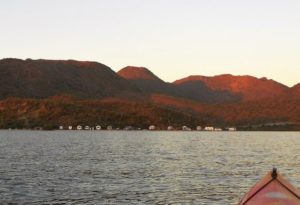
2 pm came and we picked up the group at the Pearl/Clam Shell sculpture on the Malecon. In our absence Omar showed up and Wayne & Anke were able to fill their RV with purified water. Corrine spent the day poolside and Lisa went for a swim when we returned, for me a well deserved siesta. Gabriela showed up with the laundry as expected on time, for us only $150 pesos delivered, only $19 Cdn. When we headed out for dinner at Los Magueyes, Wendy a single BC gal in the campground heading to the mainland joined us. Dinner was good as always at Los Magueyes, Alfonso took good care of everyone, we even had some Flaming Flan. When we left it started raining and we were treated to lighting and thunder. This made for quite a drive on the Malecon, crowded with locals taking cover from the downpour. We had planned to sit around the fire and say our goodbyes to Tim was dropping off, we delayed that because of weather and did so the next morning.
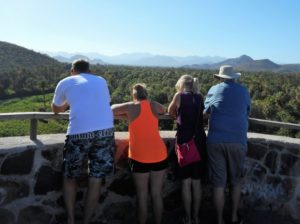
Said our goodbyes to Tim next morning and before you knew it we were back in construction. Some was better, some was worse, we know for sure “short term pain for long term gain”. Puerto Escondido, as we found out on arrival has new Mexican Owners. Yes this means prices have gone up all around, for parking the RVs as well. Sharon dropped by with lots of news and great stories. Who is Sharon? Not really sure but she was very entertaining.
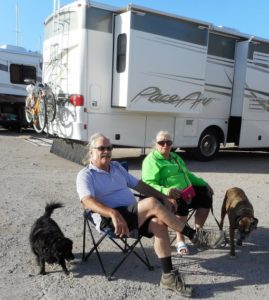
The next day we headed out at 8am and the thru Loreto Military Check Point fairly quickly. Lots of room on El Requeson, however shortly after getting everyone sorted out Thomas arrives to tell me there is a problem with where we parked. Turns out Serge complained about our group blocking his view. We have tolerated this guy, his whining, griping and complaining about other RVers for many years, no more, shared my inside voice about what I thought of him. He believes fewer RVs on Baja the better, just a self centered *%@#@#.
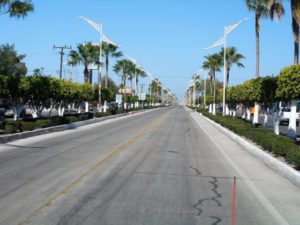
We had 3 glorious days on El Requeson, no wind until 3 pm, then only a breeze, lots of water time and down time. Fast Eddy & The Slow Learners made an appearance at Beuaventura and some of the group went; we will catch Larry & Linda when we return in January. Mark’s son Nathan made an appearance with his girlfriend Melissa on a Paddleboard, it was good to see him and have a chat.

We arrived at Hotel Serenidad, Mulege for 2 days, time to resupply and look around, another week yet to go on the tour. Got out at 1pm for an excursion of the local sites, tomorrow we head into town for some shopping and look around, maybe lunch as well. Last night a few of us had dinner at the Hotel, very good. Much more to see and do.
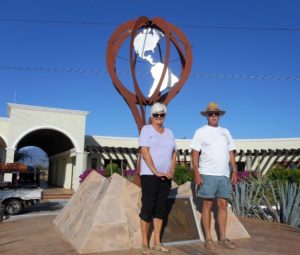
Did you know?
The whale shark (Rhincodon typus) is a slow-moving filter feeding shark and the largest known extant fish species. The largest confirmed individual had a length of 12.65 m (41.5 ft) and a weight of about 21.5 t (47,000 lb). Unconfirmed claims of considerably larger individuals, over 14 m (46 ft) long and weighing at least 30 t (66,000 lb), are not uncommon. The whale shark holds many records for sheer size in the animal kingdom, most notably being by far the largest living nonmammalian vertebrate. It is the sole member of the genus Rhincodon and the only extant member of the family, Rhincodontidae (called Rhiniodon and Rhinodontidae before 1984), which belongs to the subclass Elasmobranchii in the class Chondrichthyes. The species originated about 60 million years ago.
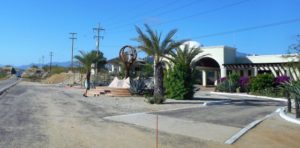
The whale shark is found in open waters of the tropical oceans and is rarely found in water below 22 °C (72 °F). Modeling suggests a lifespan of about 70 years, but measurements have proven difficult. They have very large mouths and are filter feeders, which is a feeding mode that occurs in only two other sharks, the megamouth shark and the basking shark. They feed almost exclusively on plankton and, therefore, are completely harmless to humans. The species was distinguished in April 1828 after the harpooning of a 4.6 m (15 ft) specimen in Table Bay, South Africa. Andrew Smith, a military doctor associated with British troops stationed in Cape Town, described it the following year. The name “whale shark” directly refers to the fish’s size, being as large as some species of whales and also that it is a filter feeder like baleen whales.

Distribution and habitat
The whale shark inhabits all tropical and warm-temperate seas. The fish is primarily pelagic, living in the open sea but not in the greater depths of the ocean, although it is known to occasionally dive to depths of as much as 1,800 metres (5,900 ft). Seasonal feeding aggregations occur at several coastal sites such as the southern and eastern parts of South Africa; Saint Helena Island in the South Atlantic Ocean; Gulf of Tadjoura in Djibouti, Gladden Spit in Belize; Ningaloo Reef in Western Australia; Lakshadweep, Gulf of Kutch and Saurashtra coast of Gujarat in India; Útila in Honduras; Southern Leyte; Donsol, Pasacao and Batangas in the Philippines; off Isla Mujeres and Isla Holbox in Yucatan and Bahía de los Ángeles in Baja California, México; Ujung Kulon National Park in Indonesia; Cenderawasih Bay National Park in Nabire, Papua, Indonesia; Nosy Be in Madagascar Off Tofo Reef near Inhambane in Mozambique; the Tanzanian islands of Mafia, Pemba, Zanzibar; Gulf of Tadjoura in Djibouti, the Ad Dimaniyat Islands in the Gulf of Oman and Al Hallaniyat islands in the Arabian Sea; and, very rarely, Eilat, Israel and Aqaba, Jordan. Although typically seen offshore, it has been found closer to land, entering lagoons or coral atolls, and near the mouths of estuaries and rivers. Its range is generally restricted to about 30° latitude. It is capable of diving to depths of at least 1,286 m (4,219 ft), and is migratory.

On 7 February 2012, a large whale shark was found floating 150 kilometres (93 mi) off the coast of Karachi, Pakistan. The length of the specimen was said to be between 11 and 12 m (36 and 39 ft), with a weight of around 15,000 kg (33,000 lb).
In 2011, more than 400 whale sharks gathered off the Yucatan Coast. It was one of the largest gatherings of whale sharks recorded. Aggregations in that area are among the most reliable seasonal gatherings known for whale sharks, with large numbers occurring in most years between May and September. Associated ecotourism has grown rapidly to unsustainable levels.

Whale sharks have a mouth that can be 1.5 m (4.9 ft) wide, containing 300 to 350 rows of tiny teeth and 10 filter pads which it uses to filter feed. Whale sharks have five large pairs of gills and the head is wide and flat with two small eyes at the front They are grey with a white belly and their skin is marked with pale yellow spots and stripes which are unique to each individual. The whale shark has three prominent ridges along its sides and their skin can be up to 10 cm (3.9 in) thick. The shark has a pair of dorsal fins and pectoral fins. Juveniles’ tails have a larger upper fin than lower fin, while the adult tail becomes semilunate and the whale shark’s spiracles are just behind its eyes.
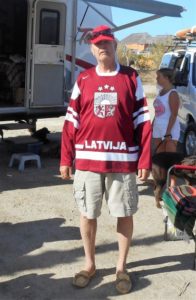
The whale shark is the largest non-cetacean animal in the world and the average size of adult whale sharks is estimated at 9.7 m (31.82 ft) and 9 t (20,000 lb). Several specimens over 18 m in length have been reported and as stated earlier the largest verified specimen was caught on 11 November 1947, near Baba Island, in Karachi, Pakistan. It was 12.65 m (41.50 ft) long, weighed about 21.5 t (47,000 lb), and had a girth of 7 m (23.0 ft). Stories exist of vastly larger specimens– quoted lengths of 18 m (59 ft) and 45.5 t (100,000 lb) are common in the popular literature, but no scientific records support their existence. In 1868, the Irish natural scientist Edward Perceval Wright obtained several small whale shark specimens in the Seychelles, but claimed to have observed specimens in excess of 15 m (49.2 ft), and tells of shark specimens surpassing 21 m (68.9 ft).

In a 1925 publication, Hugh M. Smith described a huge animal caught in a bamboo fish trap in Thailand in 1919. The shark was too heavy to pull ashore, but Smith estimated the shark was at least 17 m (56 ft) long, and weighed around 37 t. These measurements have been exaggerated to 43 t (95,000 lb) and a more precise 17.98 m (59.0 ft) in recent years. A shark caught in 1994 off Tainan County, southern Taiwan, reportedly weighed 35.8 t (79,000 lb). There have even been unverified claims of whale sharks of up to 23 metres (75 ft) and 100 tonnes (220,000 lb). In 1934, a ship named the Maurguani came across a whale shark in the southern Pacific Ocean, rammed it, and the shark became stuck on the prow of the ship, supposedly with 4.6 m (15 ft) on one side and 12.2 m (40 ft) on the other. No reliable documentation exists for these claims and they remain “fish stories”.
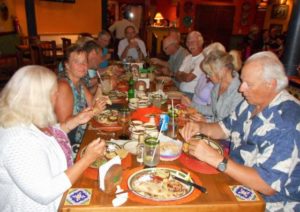
The whale shark is a filter feeder – one of only three known filter feeding shark species (along with the basking shark and the megamouth shark). It feeds on plankton including copepods, krill, fish eggs, Christmas Island red crab larvae and small nektonic life, such as small squid or fish. It also feeds on clouds of eggs during mass spawning of fish and corals. The many rows of vestigial teeth play no role in feeding. Feeding occurs either by ram filtration, in which the animal opens its mouth and swims forward, pushing water and food into the mouth, or by active suction feeding, in which the animal opens and closes its mouth, sucking in volumes of water that are then expelled through the gills. In both cases, the filter pads serve to separate food from water. These unique, black sieve-like structures are presumed to be modified gill rakers. Food separation in whale sharks is by cross-flow filtration, in which the water travels nearly parallel to the filter pad surface, not perpendicularly through it, before passing to the outside, while denser food particles continue to the back of the throat. This is an extremely efficient filtration method that minimises fouling of the filter pad surface. Whale sharks have been observed “coughing”, presumably to clear a build-up of particles from the filter pads. Whale sharks migrate to feed and possibly to breed.

Despite its size, the whale shark does not pose significant danger to humans. Whale sharks are docile fish and sometimes allow swimmers to catch a ride, although this practice is discouraged by shark scientists and conservationists because of the disturbance to the sharks. Younger whale sharks are gentle and can play with divers. Underwater photographers such as Fiona Ayerst have photographed them swimming close to humans without any danger. The shark is seen by divers in many places, including the Bay Islands in Honduras, Thailand, the Philippines, the Maldives close to Maamigili (South Ari Atoll), the Red Sea, Western Australia (Ningaloo Reef, Christmas Island), Taiwan, Panama (Coiba Island), Belize, Tofo Beach in Mozambique, Sodwana Bay (Greater St. Lucia Wetland Park) in South Africa, the Galapagos Islands, Saint Helena, Isla Mujeres (Caribbean Sea), La Paz, Baja California Sur and Bahía de los Ángeles in Mexico, the Seychelles, West Malaysia, islands off eastern peninsular Malaysia, India, Sri Lanka, Oman, Fujairah, and Puerto Rico. Juveniles can be found near the shore in the Gulf of Tadjoura, near Djibouti, in the Horn of Africa.

Two whale sharks were featured as the main attraction of Osaka Aquarium Kaiyukan and as of 2005, three whale sharks were in captivity at the Okinawa Churaumi Aquarium in Japan. The Ioworld Aquarium in Kagoshima, Japan, also features a single adult whale shark as a major attraction. One was also on display in the Taiwan, Kenting National Museum of Biology and Aquarium and 5 are on display at the Yantai Aquarium in China. Four whale sharks, two males,Taroko and Yushan, and two females, Alice and Trixie, live in the Georgia Aquarium, in Atlanta, USA. Two male whale sharks, Ralph and Norton, died in captivity at the Georgia Aquarium on 11 January 2007, and 13 June 2007, respectively. The two females were added on 3 June 2006 and two more males in 2007. All six whale sharks were imported from Taiwan, where whale sharks are called tofu sharks because of the taste and texture of the flesh; the fishery from which they came has since closed. Two whale sharks live at Polar Ocean World in Qingdao, China. One whale shark was at the Atlantis Hotel in Dubai, but was released in March 2010, there are also 2 whale sharks in the Inbursa aquarium in Mexico City.

Neither mating nor pupping of whale sharks has ever been observed. The capture of a female in July 1996 that was pregnant with 300 pups indicated whale sharks are ovoviviparous. The eggs remain in the body and the females give birth to live young which are 40 to 60 cm (16 to 24 in) long. Evidence indicates the pups are not all born at once, but rather the female retains sperm from one mating and produces a steady stream of pups over a prolonged period. They reach sexual maturity at around 30 years and their lifespan is an estimated 70 to 100 years.

On 7 March 2009, marine scientists in the Philippines discovered what is believed to be the smallest living specimen of the whale shark. The young shark, measuring only 38 cm (15 in), was found with its tail tied to a stake at a beach in Pilar, Sorsogon, Philippines, and was released into the wild. Based on this discovery, some scientists no longer believe this area is just a feeding ground; this site may be a birthing ground, as well. Both young whale sharks and pregnant females have been seen in the waters of Saint Helena in the South Atlantic Ocean, where numerous whale sharks can be spotted during the summer.
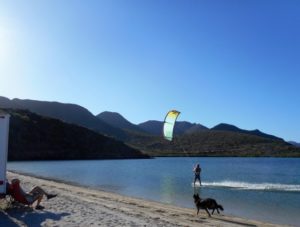
Interesting enough a whale shark depicted on the 100 Philippine peso banknote. There is currently no robust estimate of the global whale shark population. The species is considered endangered by the IUCN due to the impacts of fisheries, bycatch losses, and vessel strikes, combined with its long life span and late maturation. It is listed, along with six other species of sharks, under the CMS Memorandum of Understanding on the Conservation of Migratory Sharks. In 1998, the Philippines banned all fishing, selling, importing, and exporting of whale sharks for commercial purposes, followed by India in May 2001, and Taiwan in May 2007.

In 2006, Resorts World Sentosa announced its plans to bring in whale sharks for their marine life park. This was met with opposition from seven notable conservation societies. In 2009, the plan was shelved in favour of a search for other alternatives.
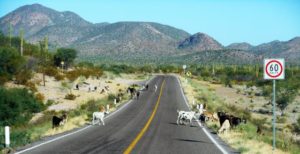
In 2010, the Gulf of Mexico oil spill resulted in 4,900,000 barrels (780,000 m3) of oil flowing into an area south of the Mississippi River Delta, where one-third of all whale shark sightings in the northern part of the gulf have occurred in recent years. Sightings confirmed that the whale sharks were unable to avoid the oil slick, which was situated on the surface of the sea where the whale sharks feed for several hours at a time. No dead whale sharks were found. This species was also added to Appendix II of the Convention on International Trade in Endangered Species of Wild Fauna and Flora (CITES) in 2003 to regulate the international trade of live specimens and its parts.
